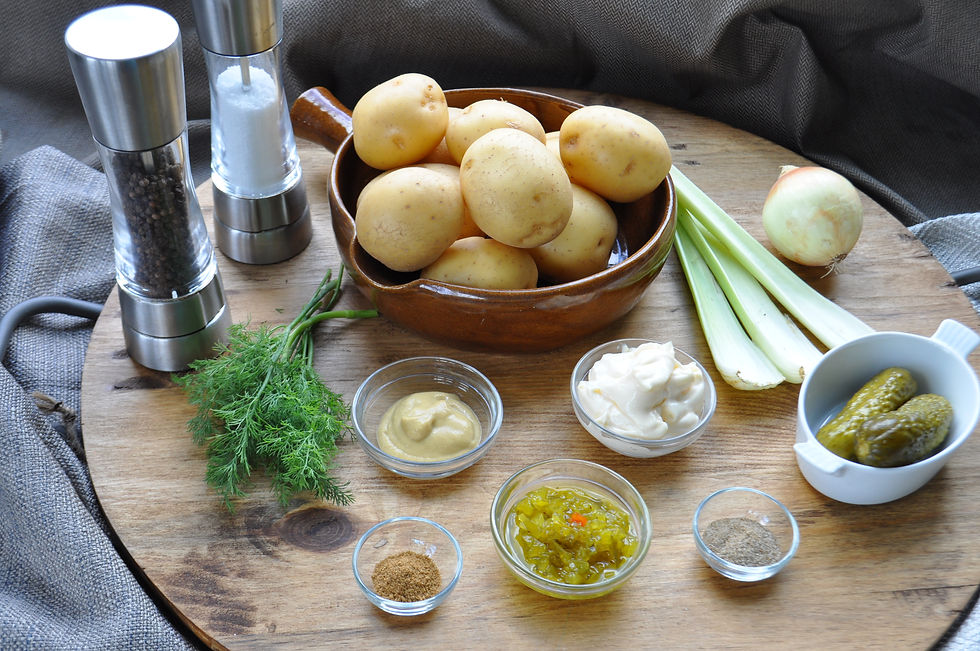- Schatzi

- Feb 5, 2023
- 3 min read
Updated: May 12, 2023

This dish is in the category of side dishes and salads. However, I believe it is not fair! Potato Salad is rich, tasty, and can be a meal on its own. So, it should have a side dish instead. What goes with it? Where do I begin? It could be as simple as Hot Dogs or meatballs. But it can also complement more cultured foods such as pan-fried chicken thighs or smoked baby back ribs. Some drier and spicy fried meats best accompany this creamy, rich taste. There is no need to add sauces to the meats since a potato salad already adds juiciness.
Most store-bought potato salads have rather large pieces of potato that are often undercooked. The choice of russet potatoes makes it too earthy and grainy. I choose Yukon gold potatoes, which have a relatively smooth, velvety taste but stay firm (if cooked right). I choose to cut them into small cubes so you can enjoy more of the tasty creamy dressing than just plain potato.
It would be best to use fresh dill, not the dried version. Although dried dill goes well in many dressings, it will not develop enough taste in a dressing that is not very liquidy.
You can add many ingredients to the salad, such as vegetables, eggs, fried bacon, or - yes, and I said it - herring, which you sometimes find in Germany. My mother added some Salmon Roe Caviar as a garnish on top.
I started a little easier in this recipe with celery and dill pickles. It gives a little crunch to the salad with a slightly herbal, sweet aroma. Just be brave and experiment with it.
Ingredients
2 lb Yukon Gold Potatoes
3 stalks Celery
1 Onion
2 Dill Pickle
1/2 cup Mayonnaise
1/3 cup Sweet Relish
2 Tbsp German Mustard (substitute with Dijon Mustard)
3 Tbsp Apple Cider Vinegar
3 Tbsp fresh Dill, chopped (substitute with only 2 Tbsp dried dill)
1 Tbsp Ground Coriander
1 Tbsp Celery Salt (or better Celery Seeds)
Salt and Pepper to taste (be easy on the Salt if you use Celery Salt!)
(Optional) 1 hard boiled Egg, cut into small pieces

Garnish
Parsley
Hungarian Paprika
The process
Peel the potatoes and cut them into 1/2-inch cubes. Make sure the cubes are pretty much the same size so they will be cooked with the same softness.
Wash the potato pieces and boil them in water until they are not too soft (aldente) for about 12-15 minutes. The potatoes will cook a little more when resting.
While boiling the potatoes, cut the celery into 1/4 inch pieces and the onion even smaller. Quarter the dill pickle lengthwise and slice the quarters. The pieces only complement the salad and should not be too large.
Mix mayonnaise, sweet relish, Dijon mustard, dill, and spices. Add onions, dill pickles, and celery to the dressing and mix well.
When the potatoes are soft enough, drain them and return to the pot. Add the apple cider vinegar when the potatoes are still hot, and mix well. Don't stir too vigorously, so the potatoes are not falling apart. Let them cool down.
When potatoes are still lukewarm (to the touch), add the dressing and fold it in carefully not to smash the potatoes. I like the salad when it is still a little warm, but you can put it in the refrigerator if you like it better.
Garnish it with parsley and a pinch of Hungarian paprika.
You can keep the potato salad in the refrigerator for 3-4 days. Unfortunately, you cannot freeze it, so enjoy it soon!
Choose wine and music according to the main dish if this is a side dish. Otherwise:
Wine Pairing
Dry Riesling
- Trimbach Classic Riesling from the Alsace or
- Stein Riesling Blauschiefer Trocken, from Mosel, Germany
Why:
Dry Riesling offers a non-sweet fruitiness. It includes minerality and acidity, which perfectly balances the potato salad's creaminess. The wine's dryness helps to offset the heaviness of the salad.
Music Pairing
Maroon 5 - Sugar and other songs from the album V
Why:
Imagine eating your potato salad at a barbecue outside in the summer. You are standing, holding your plate with the salad, and swaying with the music. The song sugar gets you on your feet and is perfect for this event.




